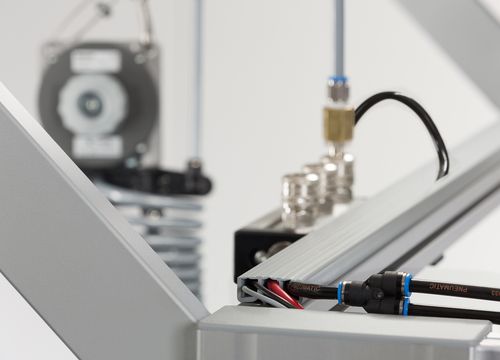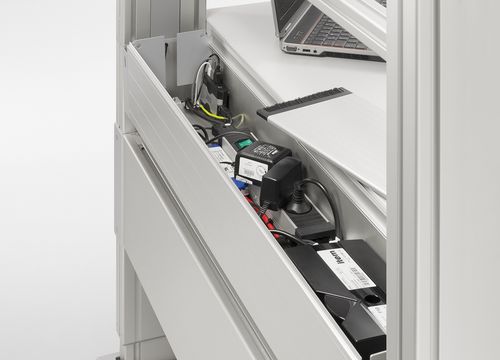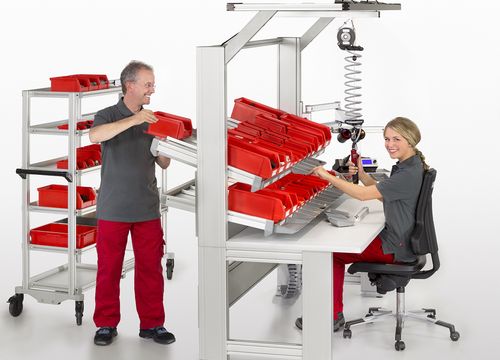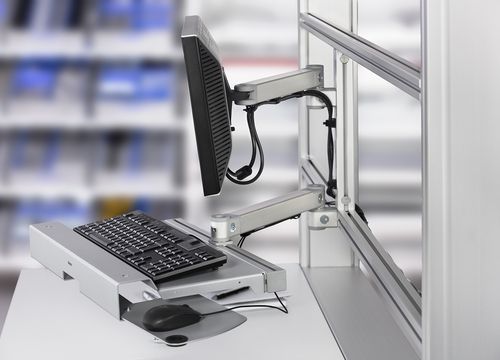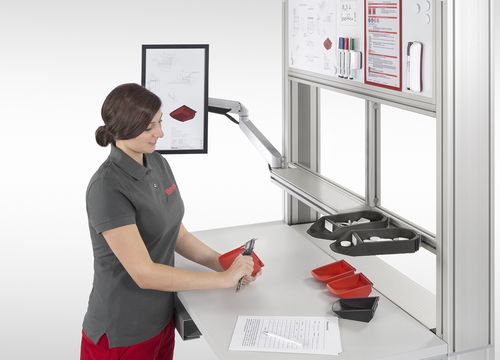Slewable Monitor Arms ensure screens can be moved into the perfect position to prevent constrained postures.
A smart factory is a place where machines communicate with each other, take decisions independently and manage production on an entirely autonomous basis. It is also a place where people are few and far between. If we are to believe the kinds of scenarios that are being put forward, intelligent robots could end up demoting people to the role of mere helpers in the production process – or forcing them out altogether. Indeed, will the industrial workstations of the future have to factor in the needs of workers at all? However, if people are still going to be an important factor in the production process, that raises another question – how will Industry 4.0 change the workplace? Marius Geibel, Product Manager and expert for ergonomics at item, has the answer.
Production is changing. Traditional mass production is falling out of favour and is being replaced by the series-production of customised one-offs. Although that may seem like a contradiction in terms, it is now possible, thanks to the automation, intelligent networking and digitalisation of production processes – or Industry 4.0 for short. To enable flexible, customised production in a batch size of one, all the stations in a value-added chain must be networked. The processes upstream and downstream of production, such as inbound and outbound logistics, have to continuously share data, both amongst themselves and with all stages of the production process. Indeed, coordination problems can bring the production system grinding to a halt, for instance if material needed from the warehouse isn’t available on time at the work bench. As a result, the provision and transmission of information and closer links with overarching systems will become especially important as time goes on. This process unlocks opportunities, but also raises new challenges that companies must tackle.
Today – it’s all about ergonomics.
To date, people have been irreplaceable as the cornerstone of the production process, their abilities unique and their intelligence unrivalled. Similarly, the manual work bench – the place responsible for the biggest share of value creation – has had a very special significance. The focus has been first and foremost on ergonomic factors designed to boost the productivity of employees. Closely tied in with ergonomics is the customisability of the work bench. One example would be work chairs that can be adjusted to user needs and therefore support ergonomic working at a range of heights. Benches with stepless height-adjustment systems also enable rapid switching from standing to sitting work and vice-versa. To prevent one-sided movements, state-of-the-art work bench systems allow users to position tools and materials precisely where they are needed, and LED and daylight lamps help to improve concentration and reduce the risk of errors. Manufacturers are also accounting for the influx of IT into work benches, adding screens and monitors in ergonomic arrangements and safely stowing cables and leads in cable ducts and conduits. “For example, if staff have to regularly consult a monitor, it should be placed in their direct field of vision and not off to the side somewhere. Otherwise, they have to adopt constrained postures, which can result in painful physical strain. Slewable monitor arms are a good way of preventing poor posture, because they can be manoeuvred into the perfect position,” explains Marius Geibel, Product Manager and ergonomics expert at item. State-of-the-art industrial work benches have a modular design and can be extended to suit requirements. That makes it easy to adapt them to constantly changing requirements. “For example, if the whole principle of material supply at the bench changes, workers using a modular system can adapt to the new requirements quickly and easily – perhaps even without any downtime in production,” adds Geibel.
The requirements of ergonomic work benches and efficient intralogistics also need to be given equal weighting when designing work benches. Simple, rapid material supply, short reaching distances, safe parts handling and the clear labelling and allocation of material containers all optimise workflows and boost productivity.
Tomorrow – machines take the strain for staff
Will the production process of the future still have space for a work bench that is geared toward the needs of human workers carrying out manual activities? That’s a question that Geibel answers with a very clear “yes”: “No robot can replace the cognitive abilities of a human worker. Humans are clearly superior to machines, particularly when it comes to complex motor skills.” That is why ergonomics will stay at the top of the agenda in the future – particularly given how the population is changing. “Due to an aging population, the number of skilled workers in companies is shrinking, so businesses really have to look out for their health and capabilities,” says the ergonomics expert. In an ideal scenario, the digitalisation and networking of the working environment should therefore also lighten the load for staff. Despite increasing automation, there will still be some assembly work that has to be done manually. This is where collaborative robots come into play, and the factories of the future will make increasing use of them. These robots work in direct contact with people and are tasked with relieving employees of physically demanding and unergonomic tasks such as lifting and positioning a heavy workpiece. However, there are a number of special safety criteria that need to be factored in when designing work benches that use collaborative robots. For instance, the risk of injuries from potential collisions between human workers and robots needs to be minimised and steps have to be taken to ensure staff are not restricted in terms of their movement. Cyber-physical objects (CPOs) are another source of support. A tool that is classed as a CPO also presents information and issues instructions about which assembly step is next. Alternatively, it may pick its own operator, based on the physical condition of employees. So, is that all science fiction, or is it set to become reality soon?
Keeping staff on side
Geibel is certain that the working environment will not change radically for staff. “I don’t anticipate a far-reaching revolution in workplace design. Lots of elements that are relevant today will simply be even more relevant in the future, such as ergonomics, customisation and modularity,” says Geibel. He is confident that, although staff are going to have to get to grips with new technologies on a more frequent basis, they aren’t going to be replaced by them.
That leaves the question of what companies should do next. If people are part of the plan for Industry 4.0, their requirements are still going to be at the top of the agenda when it comes to work bench design. Companies should focus first and foremost on ergonomics, customisability and modularity to ensure they are an attractive employer for future generations, too, and to make sure they are well equipped for future challenges. Training courses are available to support the right kind of approach and give engineers valuable tips for work bench design. It is also advisable to prepare staff for new technologies in plenty of time and bring them on board when it comes to making decisions that affect their direct working environment. “Without acceptance and trust, companies can’t achieve future-proof work bench design,” points out Geibel.

